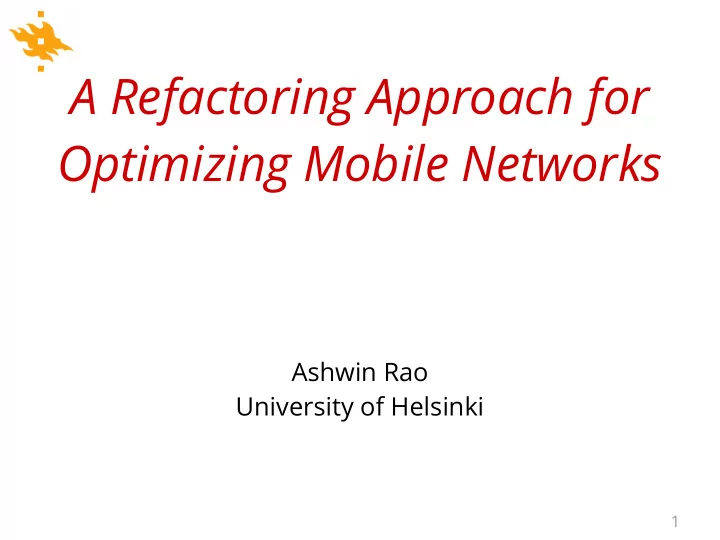

A Refactoring Approach for Optimizing Mobile Networks Ashwin Rao University of Helsinki 1
A Refactoring Approach for Optimizing Mobile Networks Matteo Pozza, Ashwin Rao, Armir Abujari, Claudio Pallazi, Hannu Flinck, and Sasu Tarkoma Under submission – Short Paper to ACM CoNEXT 2016 State Space Analysis to Refactor the Mobile Core Heikki Lindholm, Lirim Osmani, Hannu Flinck, Sasu Tarkoma, and Ashwin Rao. In Proc. of AllThingsCellular Workshop 2015 Building Blocks for an Elastic Mobile Core Lirim Osmani, Binoy Chemmegate, Heikki Lindholm, Ashwin Rao, Hannu Flinck, and Sasu Tarkoma In ACM CoNEXT Student Workshop 2014. 2
Background ● Mobile networks are expecting an in1ux of verticals with varying demands – Low latency e.g., for haptic feedback – Gbps uplink/downlink e.g., for high quality video – High mobility e.g., for serving high speed trains Each vertical is expected to arrive with a unique set of requirements 10
Scaling Mobile Networks ● Why can't current LTE networks meet these demands? – Telephony Centric – IP tra?c an afterthought – Convoluted Control and Data Plane ● Approaches to address this issue – Move functionality to the Edge – Move functionality to the Cloud (NFV) 14
4G (LTE) Network Mobile Core Radio Access Network (RAN) HSS SPR MME PCRF eNodeB S-GW P-GW 24
4G (LTE) Network Mobile Core Radio Access Network (RAN) HSS SPR How do we move functionality? MME PCRF How do we refactor LTE networks? eNodeB S-GW P-GW 25
Three Layer Abstractions Mobile Network Storage Layer Control Layer Forwarding Layer 29
Modularization Objective Storage Layer HSS SPR Control MME PCRF Layer eNB S-GW P-GW Forwarding Layer 33
Identifying Roles of Network Functions ● Identify state variables used by network functions to maintain the UE state ● Study signals exchanged between network functions to update these state variables during procedures Procedure #signals Initial Attach 35 – Initial Attach Active to Idle 6 – Active to Idle Idle to Active (UE) 13 – Idle to Active Idle to Active (Net) 17 – Handovers Handover (S1H) 22 35
Identifying Modules Mobile Network HSS HSS HSS SPR SPR SPR MME MME MME PCRF PCRF PCRF eNB SGW PGW 39
Identifying Modules Mobile Network HSS HSS SPR SPR MME MME PCRF PCRF eNB (C) eNB (C) S-GW (C) S-GW (C) P-GW (C) eNB (D) eNB (D) S-GW (D) S-GW (D) P-GW (D) P-GW (D) 40
Identifying Modules Mobile Network HSS HSS SPR SPR M07 M08 M04 MME MME PCRF PCRF M06 M05 M13 eNB (C) eNB (C) S-GW (C) S-GW (C) P-GW (C) M12 M11 M10 M02 M03 M01 eNB (D) eNB (D) S-GW (D) S-GW (D) P-GW (D) P-GW (D) 45
Impact of Splitting Control and Data Planes Total number of signals per event Idle to Idle to Initial Active Active Active Handover Implementation Attach to Idle (UE) (Net) (S1H) LTE 35 6 13 17 22 (Baseline) Modular 57 11 23 29 41 LTE 46
Mapping Modules to Layers HSS SPR Storage Control MME P-GW (C) PCRF eNB (C) S-GW (C) Forwarding eNB (D) P-GW (D) S-GW (D) 50
Mapping Modules to Layers HSS SPR Storage Control MME P-GW (C) What is the impact of coalescing these modules? PCRF eNB (C) S-GW (C) Forwarding eNB (D) P-GW (D) S-GW (D) 51
Example 1: Thin Edge Radio Access Storage Network (RAN) HSS SPR Control MME PCRF eNB (C) S-GW (C) P-GW (C) GW S-GW (D) P-GW (D) eNB (D) 56
Ex2: Intelligent Edge Radio Access Network (RAN) Storage SPR HSS Control MME PCRF eNB (C) GW S-GW (C) P-GW (C) S-GW (D) eNB (D) P-GW (D) 62
Impact of Coalescing Modules Total number of signals per event Idle to Idle to Initial Active Active Active Handover Implementation Attach to Idle (UE) (Net) (S1H) LTE 35 6 13 17 22 (Baseline) Thin Edge 24 6 13 16 16 Intelligent Edge 17 3 10 12 12 63
Summary and Future Work ● Abstract the roles of the network functions ● Modularize the network functions ● Explore scenarios for coalescing the modules 64
Summary and Future Work ● Abstract the roles of the network functions ● Modularize the network functions ● Explore scenarios for coalescing the modules – Modules can become part of solutions for backward compatibility with next generation networks – Network in a Box 69
Thank You! ashwin.rao@helsinki.f 70
Recommend
More recommend